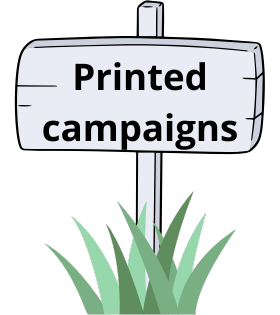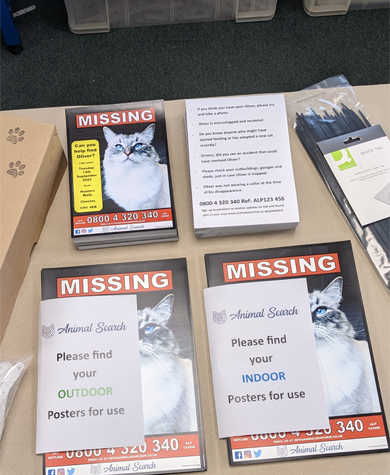
Poster & Leaflets
In our experience this is crucial to reuniting lost pets with their owners. The more material you can distribute the better as, of course, this means more people are aware of your missing pet.
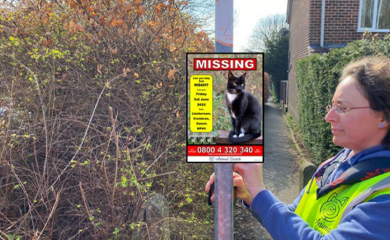
Around 20 to 50 good quality posters in your local area are recommended, but this depends on how built up your neighbourhood is and the likely search area.
A large quantity of leaflets are needed to cover a vast amount of ground. We recommend between 300-500. You can leave these in bulk in establishments for the public to take one home with them.
| Bus stations/stops | |
| Street intersections | |
| Shop windows | |
| School receptions | |
| Lamp posts | |
| Surgery waiting rooms | |
| Pubs/restaurants | |
| Neighbours house and car windows. | |
| Local takeaways |

Where do I display posters?
Putting up posters without local council permission can be considered as ‘fly-postering’, which can face you with a fine. The vast majority of local councils and neighbourhoods will tolerate missing pet posters, so long as they’re in good condition, not attached to trees or bushes (which can be damaged by the fixings) and removed after a ‘reasonable’ time. Each area will have its own interpretation of ‘reasonable’ time, however we suggest between 4 and 8 weeks would normally be acceptable.
Posters printed on standard paper will deteriorate quickly. This could become unsightly to your neighbours, or your local Environmental Health Officer, and be counter-productive to your search, so try and ensure any in bad condition are replaced quickly.
Our Missing Pet Posters and Leaflets ensure that all posters are in excellent condition, professionally designed and printed, weatherproof and anti-vandal – they’re almost impossible to rip – and consequently look great until you take them down. They come with our unique patented clips that do not damage the post they’re attached to and ensure the poster is displayed flat, as opposed to curved round poles.
Please remember that if you have pet insurance, often your policy will cover the cost of advertising for a Missing Pet.
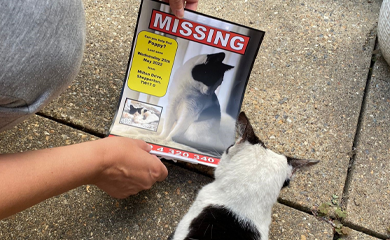
What information should I include?
Similar to social media posts, you should carefully consider the information you put on your own posters and leaflets.
| Do not disclose your full address or your house number. | |
Do not disclose your personal phone number if you can avoid it. You can purchase a pay as you go sim to use temporarily. Our Missing Pet Posters and Leaflets include our own 0800 freephone number, which is answered by our 24 / 7 Owner Support Team based in Chester, UK, so they can filter out hoax and offensive calls before passing messages on to you. |
|
Do not advertise a reward value – it is okay to say you are offering a reward, but large, advertised cash rewards can encourage hoax callers and it could put your pet at risk of being stolen in the future. We suggest just stating ‘reward’ and avoid any mention of an amount.. |
|
Do not advertise your pet's microchip number but do state if your pet is chipped. |
|
Do not mention the breed of your pet on your posters or leaflets as expensive pedigree breeds are more at risk of being stolen. when they went missing. |
|
If your pet is neutered, you should include this information as they cannot be used for breeding and may therefore be less desirable. If they are not neutered it is best not to mention this as it may increase their desirability due to the potential for breeding. |
|
Where possible, avoid using free-ad websites like Gumtree. We are aware of many people who have fallen victim to disturbing hoax calls after advertising their missing pets on these types of sites. |
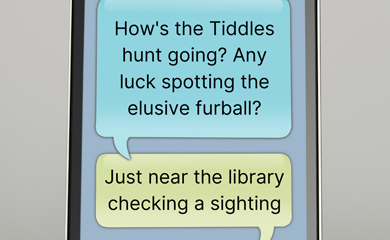
Keeping safe responding to sightings
It is important to keep yourself safe whilst responding to sightings of your pet.
Always tell someone where you are going. If possible, go with a relative or friend, especially if you are going to someone's house or to an isolated area.
Always take your mobile phone with you, and make sure it is fully charged.
Do not carry large amounts of cash - rewards can be paid later. If the finder is genuine, they will not mind this and you can exchange details to make a bank transfer or arrange to meet up again for the reward to be paid. If you are insured your insurance company will let you know how they pay rewards. This is usually paid directly to the finder by cheque.
If possible, drive to the location rather than walking or using public transport. As well as being safer, this also means that you will be able to get straight to a vet should your pet need it.
Be extremely cautious of callers who repeatedly ask questions about your pet's value, or about a reward or money for information.
Take a pet basket or carrier, a collar and lead if appropriate.

